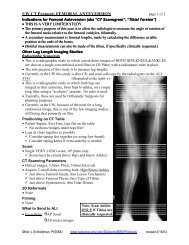Ankle and Foot 47 - Department of Radiology - University of ...
Ankle and Foot 47 - Department of Radiology - University of ...
Ankle and Foot 47 - Department of Radiology - University of ...
Create successful ePaper yourself
Turn your PDF publications into a flip-book with our unique Google optimized e-Paper software.
A<br />
B<br />
<strong>47</strong> <strong>Ankle</strong> <strong>and</strong> <strong>Foot</strong> 2315 <strong>47</strong><br />
Figure <strong>47</strong>-121. Intraosseous lipoma discovered as<br />
an incidental finding in a 43-year-old. A, Lateral<br />
radiograph <strong>of</strong> the right calcaneus shows the lucent<br />
lesion in the anterior half with a well-circumscribed<br />
border (open arrowheads). Centrally, there is a small<br />
sclerotic focus (black arrowhead), characteristic <strong>of</strong> an<br />
intraosseous lipoma. B, Lateral radiograph <strong>of</strong> the<br />
contralateral left calcaneus is shown for comparison.<br />
A lipoma, intraosseous or otherwise, should<br />
be isointense to fat on all imaging sequences. C,<br />
Midsagittal T1-weighted image shows the signal<br />
intensity <strong>of</strong> the lipoma (open arrowheads) to be<br />
isointense to that <strong>of</strong> the surrounding fatty bone<br />
marrow. The central sclerotic focus (black arrowhead)<br />
is dark on all imaging sequences. D, On the<br />
corresponding T2-weighted fat-suppressed image, the<br />
fat in the lipoma suppresses to a degree similar to that<br />
<strong>of</strong> the surrounding fatty bone marrow so that it is<br />
nearly inconspicuous.<br />
C<br />
D<br />
A<br />
B<br />
Figure <strong>47</strong>-122. Chondrosarcoma arising from the<br />
calcaneal tuberosity 30-year-old. A, Lateral<br />
radiograph. This patient complained <strong>of</strong> heel pain for<br />
10 months until the sclerosis in her calcaneus was<br />
recognized. B, Sagittal T1-weighted image shows<br />
diffusely decreased signal in the calcaneus<br />
corresponding to the radiographic sclerosis. C, Sagittal<br />
fat-suppressed T2-weighted image reveals marrow<br />
edema only at the periphery <strong>of</strong> the sclerotic region.<br />
There is, however, extensive bright signal in the s<strong>of</strong>t<br />
tissues immediately plantar to the calcaneus,<br />
indicating that the tumor is extending out <strong>of</strong> the bone<br />
<strong>and</strong> into the s<strong>of</strong>t tissues. D, Sagittal post–gadolinium<br />
contrast fat-suppressed T1-weighted image<br />
demonstrates enhancement only at the periphery <strong>of</strong><br />
the osseous <strong>and</strong> s<strong>of</strong>t tissue masses. This enhancement<br />
pattern is due to the relative hypovascularity <strong>of</strong><br />
chondrosarcomas.<br />
C<br />
D<br />
Ch0<strong>47</strong>-A05375.indd 2315<br />
9/9/2008 5:36:27 PM
















